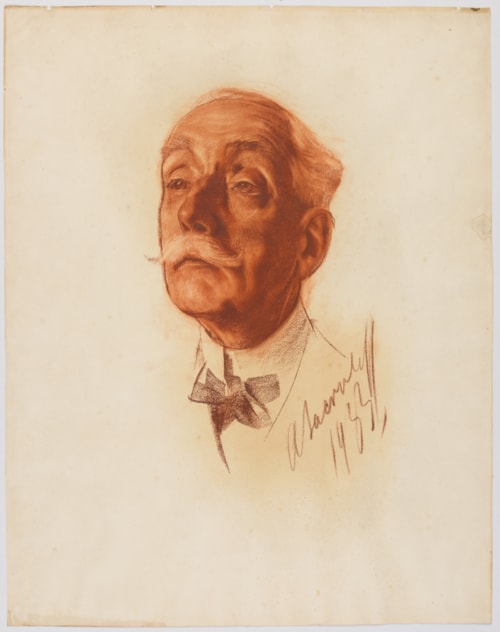
Alexander YAKOVLEV
St. Petersburg 1887 - Paris 1938
Biography
Alexander Evgenievich Yakovlev (also Iacovleff or Jacovleff) studied at the Imperial Academy of Fine Arts in St. Petersburg, where he was taught by Dmitry Kardovksy. It was there that he met his friend and fellow artist, Vasily Shukaev, with whom he travelled to Italy and Spain in 1913. This was to be the first of many travels for Yakovlev. A member of the revived Mir iskusstva group of Russian artists, he was much admired by one of the movement’s founders and leaders, Alexander Benois, who praised the young man’s talent. Following a period of military service during the First World War, Yakovlev earned a travelling scholarship to the Far East in the summer of 1917, and visited Mongolia, China and Japan. He was in Peking during the outbreak of the October Revolution, and was never to return to Russia. After some years in Peking, where he was particularly captivated by Chinese theatre, Yakovlev travelled across Mongolia and Japan, making drawings and sketches of the people and sights he encountered, some of which were exhibited in Shanghai in 1918. He settled in Paris in 1919, and the following year an exhibition of his drawings and paintings of the Far East, at the Galerie Barbazanges in Paris, made his name and established his reputation as an artiste-voyageur and a superb draughtsman. Yakovlev took French citizenship and worked on commissions for decorative mural and fresco paintings for the homes of such private patrons as the Duchesse de Gramont and Prince Yusupov. He continued to travel, however, and later kept a studio in Capri.
In 1924 Yakovlev was invited by the industrialist André Citröen to join ‘La Croisière Noire’ - a motorized expedition, sponsored by Citröen and led by Georges-Marie Haardt, to cross the African continent from Algeria to Madagascar – as its official artist. Between 1924 and 1925 the artist made hundreds of paintings and drawings of the people, animals and landscapes that the expedition encountered on its route, which were later developed into finished works in his studio in Paris. These were exhibited, to considerable critical acclaim, at the Galerie Jean Charpentier and the Pavillon de Marsan at the Louvre. In 1928 Yakovlev sent an exhibition of his work to Moscow, and three years later he joined a second Citröen expedition; the trans-Asiatic ‘La Croisière Jaune’ from Beirut to Peking. Departing in April 1931, the expedition crossed Lebanon, Iraq, Iran, Afghanistan, the Himalayas and the Gobi Desert before arriving in Peking in February 1932. The artist’s painting and drawings from ‘La Croisière Jaune’ were again shown at the Galerie Jean Charpentier in Paris in 1933. The following year Yakovlev accepted a position as the director of the painting and drawing department of the School of the Museum of Fine Arts in Boston, where he remained until 1937. Although exhibitions of his work were held in Washington, D.C., New York, Charleston and Pittsburgh, the artist missed Europe. Not long after his return to Paris, Yakovlev died of stomach cancer, a few weeks before his fifty-first birthday.



